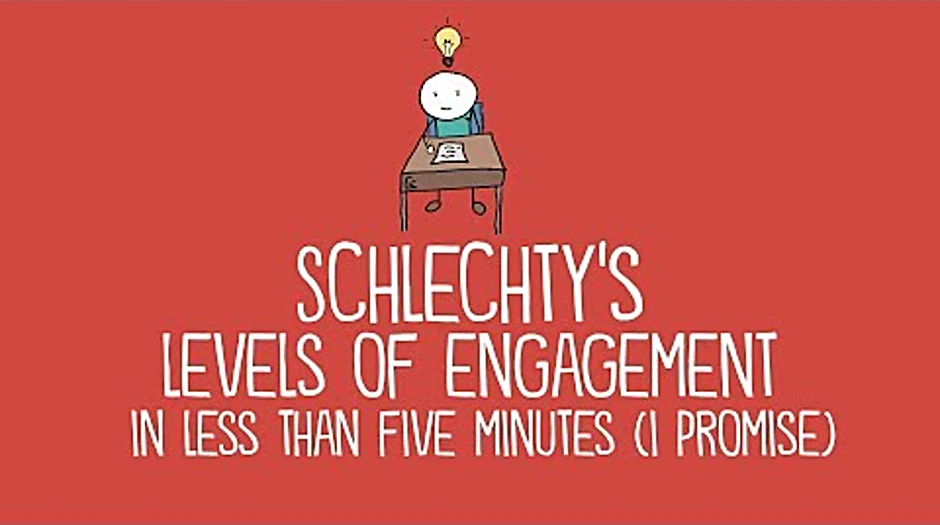LLC student engagement theory [From Experts]
Table of Contents
- What is student engagement theory?
- What are the types of engagement?
- What does student engagement look like?
- What are engagement levels?
- What are the 3 experiential learning theory?
- What is engagement theory PDF?
- What are the learning theories in education?
- How does Gallup define engagement?
- What are Kahn's three dimensions of employee engagement?
- What is zinger model?
- How many student development theories are there?
- What are the 3 elements in student engagement?
- What is Tinto's theory called?
- What are the five levels of student engagement?
- What is engagement based theory?
- What is Kahn's engagement theory?
- Who created the student engagement theory?
- What are the three types of engagement techniques?
- What are student engagement strategies?
- How do we measure student engagement?
Last updated : Aug 23, 2022
Written by : Terrence Lungstrom |
Current |
Write a comment |
What is student engagement theory?
Engagement theory (Kearsley & Shneiderman, 1998) served as the conceptual framework for the research. Engagement theory holds that students that are involved and enmeshed intellectually, socially, and behaviorally leads to enhanced learning (Kearsley & Shneiderman, 1998).
What are the 3 elements in student engagement?
In our work across schools, we've come to see three pillars of student engagement: academic, intellectual, and social-emotional. While many attributes of these pillars are organically supported during in-person learning, they all must be explicitly pursued during times of remote or blended learning.
What are the five levels of student engagement?
- Authentic Engagement [Highest Level] Students are immersed in work that has clear meaning and immediate value to them (reading a book on a topic of personal interest).
- Ritual Compliance.
- Passive Compliance.
- Retreatism.
- Rebellion [Lowest Level]
What is engagement based theory?
The Engagement Theory is a framework for technology-based teaching and learning. Its fundamental underlying idea is that students must be meaningfully engaged in learning activities through interaction with others and worthwhile tasks.
What is Kahn's engagement theory?
Work Engagement Theory of Kahn Work engagement denotes the degree to which a person shows self-preference in job tasks to promote connections between self and job, which can increase role performance through cognitive, emotional, and physical self-investment (Kahn, 1990).
Who created the student engagement theory?
A definition of student engagement that's rooted in history In the mid-1980s, psychologist and professor Alexander Astin first came up with the “Theory of involvement.†At its highest level, it attempted to measure the amount of physical and psychological energy students devote to their academic experience.
What are the three types of engagement techniques?
Engagement in the classroom falls within three categories: behavioral, cognitive, and affective (Fredericks, Blumenfeld, & Paris, 2004). These three types are distinct yet interrelated.
What are student engagement strategies?
Some common personalized learning strategies for student engagement include: Involving students in academic goal-setting for themselves. Giving students multiple opportunities to show their knowledge, from assessments to journal entries. Using flipped instruction strategies to help students learn at their own pace.
How do we measure student engagement?
- Student Self-Report Surveys. One of the most common ways to measure engagement is to have students report on the quality of their own involvement in school.
- Teacher Ratings.
- Interviews and Focus Groups.
- Observational Methods.
- Administrative Data.
- Real-Time Measures.
What are the types of engagement?
The three types of engagement are Personal Engagement, Organizational Engagement, and Situational Engagement.
What does student engagement look like?
One answer comes from educator and author, Ben Johnson, who notes that engaged students are active and do the following: pay attention, take notes, listen, ask questions, respond to questions, participate, and react.
What are engagement levels?
What are the 3 levels of engagement? 20 years back, Gallup developed the employee engagement framework, consisting of three levels. Its purpose is to help you better track how committed and dedicated your employees are. The levels are: actively engaged, not engaged, and actively disengaged.
What are the 3 experiential learning theory?
There are four key phases to the experiential learning cycle: concrete experience (CE), reflective observation (RO), abstract conceptualization (AC), and active experimentation (AE) (Figure 3) (Kolb & Kolb, 2011).
What is engagement theory PDF?
The major premise of engagement theory is that students. must be engaged in their course work in order for effective learning to occur. The theory. posits three primary means to accomplish engagement: (1) an emphasis on collaborative. efforts, (2) project-based assignments, and (3) non-academic focus.
What are the learning theories in education?
There are five primary educational learning theories: behaviorism, cognitive, constructivism, humanism, and connectivism. Additional learning theories include transformative, social, and experiential.
How does Gallup define engagement?
Gallup defines employee engagement as the involvement and enthusiasm of employees in their work and workplace. Employee engagement helps you measure and manage employees' perspectives on the crucial elements of your workplace culture.
What are Kahn's three dimensions of employee engagement?
Within his work, Kahn identified three principle dimensions of employee engagement - physical, cognitive and emotional.
What is zinger model?
The Zinger model His theory is based on decades of experience in employee psychology, assistance, engagement, and burnout. His model focuses on the importance of employee connections to one another, to the organization, to customers, to their broader community, and to the employee's own performance.
How many student development theories are there?
The five main student development theories are psychosocial, cognitive structural, person-environment, humanistic-existential, and the student developmental process model. In addition to the five main theories, there are also two secondary theories. Those include moral development and typology/adult development theory.
What is Tinto's theory called?
Tinto's "Model of Institutional Departure" states that, to persist, students need integration into formal (academic performance) and informal (faculty/staff interactions) academic systems and formal (extracurricular activities) and informal (peer-group interactions) social systems.

Check these related keywords for more interesting articles :
Apply for llc business license
What business can i start with LLC vs scorp california
What is the best LLC business to start during recessions
LLC student info sheet
Rule of three LLC vs sole proprietor
Can a small business be an llc
How to sign lease as an LLC
What is LLC in amazon by enablers office
What is LLC statement of information
How long does a LLC take me to church
How to purchase a vehicle with your LLC
Best llc service w4
Compare llc formation service
LLC formation secretary of state
How to look up someones llc
Did you find this article relevant to what you were looking for?
Write a comment
Comment by Mose Berman
it is a framework for technology-based teaching and learning it encompasses the fundamental idea that students must be engaged in activities through interaction with others and worldwide tasks the theory suggests there are three principles of engaged learning with a related collaboration through learning being the first where activities should emphasize team effort which emphasizes on communication management planning and social skill because when students are able to discuss and defend their ideas motivation to learn increases the second principle of engaged learning is create learning using a project based approach in this instance activities should be creative and purposeful when students are given the chance to define organize and complete their own projects they develop a sense of ownership of the project and of their own learning the last principle is donate learning using an authentic focus activity should have a meaningful and realistic focus ideally each project has an outside customer such as a campus group government agency and local business this better prepares students for the workforce in a given field the theory also states that in order for students to be productive they must find lessons meaningful and have a high level of interest in the task as they learn more effectively tend to retain the information when called upon and are able to integrate it into other activities class context the teacher could facilitate learning industry by integrating technology for example allowing students to collaborate using google docs and slideshare to work on presentation and support i see where the ideas of this theory are employed in the same course when we the students are placed into very cool rooms where we collaborate with each other to research on a given topic to present our finding in google doc or slideshare you
Thanks for your comment Mose Berman, have a nice day.
- Terrence Lungstrom, Staff Member
Comment by Alvaro
select these levels of engagement in less than five minutes I promise if you watch this scene from Ferris Bueller's Day Off you'll notice that even in the midst of a boring lesson none of the students are actually misbehaving they're quiet nobody's tossing spitballs or playing those paper football games or checking their cell phones because while the cell phones back then were the size of a brick remember the Zack Morris phone but most of the students are essentially following the rules they aren't engaged but what are they well some seem to be retreating the few seem to be playing the game of school but nobody is actually committed to the learning well here's where selectees levels of engagement becomes helpful and provides a useful framework for thinking about what it means for students to be genuinely engaged in their learning selectee defines it this way engagement is active it requires the students to be attentive as well as in attendance it requires students to be committed to the task and find some inherent value in what he or she is being asked to do the engaged student not only does the task assigned but also does the task with enthusiasm and diligence in 2002 Philip schlechty developed a framework for thinking about student engagement based on two core ideas of attention and commitment at the bottom you have rebellion which involves diverted attention and no commitment to the task this is the student who seems to be acting out and causing disruptions and as a result they fail to learn from the task next you have retreat ism with no attention and no commitment unlike the rebellion this student in retreat is not actively disrupting the learning but instead seems to be kind of checked out this student is often distracted and emotionally withdrawn from the task and as a result this student learns little or nothing from the task at the next level you have ritual compliance this involves both low attention and low commitment unlike retreat ism a ritually compliant student doesn't completely check out but instead is doing the bare minimum to avoid confrontation this student will learn at a low level and the task will not be retained over time next is strategic compliance often this looks like engagement because the student might be performing at a high level but it's not here the student has high attention on the task but low commitment to what he or she is doing this is the student who is playing the game of school focused on things like grades parental approval rewards and class rank but the learning isn't intrinsically rewarding and as a result this student who will often learn at a high level but fails to retain the learning over time or transfer it to a new content and then finally you have engagement this requires both high attention and high commitment Harris student completely buys in at a strong sense of intrinsic motivation and this includes meaning and choice and challenge this student will continue focusing even when the task gets more complex and challenging and often they're going to choose to learn even when it is ungraded this student will learn at a deep level and a transfer will continue to new context and this is why it's important that we as teachers focus on how to make the subject intrinsically engaging and this happens when we tap into student curiosity and creativity and purpose and when this happens students are more likely to grow into passionate lifelong learners
Thanks Alvaro your participation is very much appreciated
- Terrence Lungstrom
About the author

Terrence Lungstrom
I've studied labor law at Alfred State College in Alfred and I am an expert in computational archaeology. I usually feel envious. My previous job was medical records technician I held this position for 28 years, I love talking about chemistry and art. Huge fan of Rupert Everett I practice golf and collect first day covers.
Try Not to laugh !
Joke resides here...
Tags
What are the types of engagement
What does student engagement look like
What are engagement levels
What are the 3 experiential learning theory
What is engagement theory PDF
What are the learning theories in education
How does Gallup define engagement
What are Kahn s three dimensions of employee engagement
What is zinger model
How many student development theories are there
What are the 3 elements in student engagement
What is Tinto s theory called
What are the five levels of student engagement
What is engagement based theory
What is Kahn s engagement theory
Who created the student engagement theory
What are the three types of engagement techniques
What are student engagement strategies
How do we measure student engagement
 : 8862
: 8862

